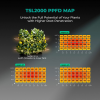The biggest plus is to get lots of light on the plant. Nutes, topping, magic incantations are all for naught if you're not getting lotsa light on your plant.Mars Hydro TSL2000. Full spectrum. Not a veg light.
I haven't done any LST lol. This is all natural. So I have one telling me not to top, and one telling me to top. I'm confused. I apologize for going back and forth here, I just want to optimize the plants. I usually end up with branches too low to produce good bud, mostly popcorn. You guys leave the lower branches, too?
My advice - spend $32 on a light meter and get 1000µmol on your grow. There's simply nothing in the grow environment that can make up for not feeding your plant. Light is the only way that plants make food and, with a light light the TSL 2000 you can get plenty of photons on your grow.
I've attached the PPFD map for that light and Mars has really upped their game. It's a little weak around the edges but you can still get a fine crop if you turn up the dial.
That doesn't click with a lot of growers but, over the past few years, I've seen a shift toward accepting that plants do better with more light.
I've also attached a picture of the parameters of the grow environment (use is as a checklist to get your grow squared away) as well as a PDF I wrote about how to convert lux meter readings to PPFD.
The only thing I'd ever grown before I grew cannabis was "old" but I've followed the basics and it's amazing how much cannabis you'll get if you just give it lots of light, water it, and don't muck with it. And I've had superb yields from autos. The way they grow, their beasts, and have zero complaints about yields.









